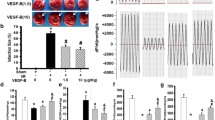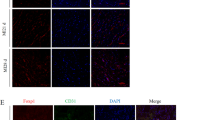Abstract
Chronic cardiac ischemia/hypoxia induces coronary collateral formation and cardiomyocyte proliferation. Hypoxia can induce cellular adaptive responses, such as synthesis of VEGF for angiogenesis and IGF-2 for proliferation. Both reduce apoptotic effects to minimize injury or damage. To investigate the mechanism of neoangiogenesis and proliferation of fetal heart under umbilical cord compression situation, we used H9c2 cardiomyoblast cell culture, and in vivo embryonic hearts as our study models. Results showed hypoxia induced not only the increase of IGF-2 and VEGF expression but also the activation of their upstream regulatory genes, HIF-1α and Shh. The relationship between HIF-1α and Shh was further studied by using cyclopamine and 2-ME2, inhibitor of Shh and HIF-1α signaling, respectively, in the cardiomyoblast cell culture under hypoxia. We found that the two inhibitors not only blocked their own signal pathway, but also inhibited each other. The observations revealed when fetal heart under hypoxia that HIF-1α and Shh pathways maybe involve in cell proliferation and neoangiogenesis to minimize injury or damage, whereas the complex cross-talk between the two pathways remains unknown.






Similar content being viewed by others
References
Chi NC, Karliner JS (2004) Molecular determinants of responses to myocardial ischemia/reperfusion injury: focus on hypoxia-inducible and heat shock factors. Cardiovasc Res 61:437–447
Clark KE, Irion GL (1992) Fetal hemodynamic response to maternal intravenous nicotine administration. Am J Obstet Gynecol 167:1624–1631
Lyon HM, Holmes LB, Huang T (2003) Multiple congenital anomalies associated with in utero exposure of phenytoin: possible hypoxic ischemic mechanism? Birth Defects Res A Clin Mol Teratol 67:993–996
Carmeliet P, Dor Y, Herbert JM et al (1998) Role of HIF-1α in hypoxia-mediated apoptosis, cell proliferation and tumour angiogenesis. Nature 394:485–490
Feldser D, Agani F, Iyer NV et al (1999) Reciprocal positive regulation of hypoxia-inducible factor 1α and insulin-like growth factor 2. Cancer Res 59:3915–3918
Iyer NV, Kotch LE, Agani F et al (1998) Cellular and developmental control of O2 homeostasis by hypoxia-inducible factor 1α. Genes Dev 12:149–162
Zhong H, Agani F, Baccala AA et al (1998) Increased expression of hypoxia-inducible factor 1α in rat and human prostate cancer. Cancer Res 58:5280–5284
Stiehl DP, Jelkmann W, Wenger RH et al (2002) Normoxic induction of the hypoxia-inducible factor 1α by insulin and interleukin-1 beta involves the phosphatidylinositol 3-kinase pathway. FEBS Lett 512:157–162
Zelzer E, Levy Y, Kahana C et al (1998) Insulin induces transcription of target genes through the hypoxia-inducible factor HIF-1α/ARNT. EMBO J 17:5085–5094
Zhong H, Chiles K, Feldser D et al (2000) Modulation of hypoxia-inducible factor 1α expression by the epidermal growth factor/phosphatidylinositol 3-kinase/PTEN/AKT/FRAP pathway in human prostate cancer cells: implications for tumor angiogenesis and therapeutics. Cancer Res 60:1541–1545
Jetten AM (1991) Growth and differentiation factors in tracheobronchial epithelium. Am J Physiol 260:L361–L373
D’Ercole AJ (1987) Somatomedin/insulin-like growth factors and fetal growth. J Dev Physiol 9:481–495
Kobayashi S, Clemmons DR, Venkatachalam MA (1991) Colocalization of insulin-like growth factor binding protein with insulin-like growth factor-I. Am J Physiol 261:F22–F28
Grothey A, Voigt W, Schober C et al (1999) The role of insulin-like growth factor I and its receptor in cell growth, transformation, apoptosis, and chemoresistance in solid tumors. J Cancer Res Clin Oncol 125:166–173
Rappolee DA, Strum KS, Behrendsten O et al (1992) Insulin-like growth factor II acts through an endogenous growth pathway regulated by imprinting in early mouse embryos. Genes Dev 6:939–952
Grant MB, Mames RN, Fitzgerald C et al (1993) Insulin-like growth factor as an angiogenic agent: in vivo and in vitro studies. Ann NY Acad Sci 692:230–242
Pola R, Ling LE, Aprahamian TR et al (2003) Postnatal recapitulation of embryonic hedgehog pathway in response to skeletal muscle ischemia. Circulation 108:479–485
Pola R, Ling LE, Silver M et al (2001) The morphogen sonic hedgehog is an indirect angiogenic agent upregulating two families of angiogenic growth factor. Nat Med 7:706–711
Magal E, Goldin E, Harel S et al (1988) Acute uteroplacental ischemic embryo: lactic acid accumulation and prostaglandin production in the fetal rat brain. J Neurochem 51:75–80
Levy R, Glozman S, Milman D et al (2002) Ischemic reperfusion brain injury in fetal transgenic mice with elevated levels of copper-zinc superoxide dismutase. J Perinat Med 30:158–165
Nishimaki H, Kasai K, Kozaki KI et al (2004) A role of activated Sonic hedgehog signaling for the cellular proliferation of oral squamous cell carcinoma cell line. Biochem Biophys Res Commun 314:313–320
Giordano FJ, Gerber HP, Williams, SP et al (2001) A cardiac myocyte vascular endothelial growth factor paracrine pathway is required to maintain cardiac function. Proc Natl Acad Sci USA 98:5780–5785
Byrne AT, Southgate J, Brison DR et al (2002) Regulation of apoptosis in the bovine blastocyst by insulin and the insulin-like growth factor (IGF) superfamily. Mol Reprod Dev 62:489–495
Steinbrech DS, Mehrara BJ, Saadeh PB et al (2000) Hypoxia increases insulin-like growth factor gene expression in rat osteoblasts. Ann Plast Surg 44:529–535
Averbukh E, Weiss O, Halpert M et al (1998) Gene expression of insulin-like growth factor-1, its receptor and binding proteins in retina under hypoxic conditions. Metabolism 47:1331–1336
Guan J, Skinner SJ, Beilharz EJ et al (1996) The movement of IGF-1 into the brain parenchyma after hypoxic-ischemic injury. Neuroreport 7:632–636
Giordano FJ, Ping P, McKirnan MD et al (1996) Intracoronary gene transfer of fibroblast growth factor-5 increases blood flow and contractile function in an ischemic region of the heart. Nat Med 2:534–539
Hendel RC, Henry TD, Rocha-Singh K et al (2000) Effect of intracoronary recombinant human vascular endothelial growth factor on myocardial perfusion: evidence for a dose-dependent effect. Circulation 101:118–121
Laham RJ, Sellke FW, Edelman ER et al (1999) Local perivascular delivery of basic fibroblast growth factor in patients undergoing coronary bypass surgery: results of a phase I randomized, double-blind, placebo-controlled trial. Circulation 100:1865–1871
Acknowledgments
This work was supported by grant from the National Science Council of Republic of China (NSC94-2316-B-039-002).
Author information
Authors and Affiliations
Corresponding author
Additional information
Pei-Cheng Lin, Chih-Yang Huang, and Wei-Wen Kuo contributed equally to this work.
Rights and permissions
About this article
Cite this article
Hwang, JM., Weng, YJ., Lin, J.A. et al. Hypoxia-induced compensatory effect as related to Shh and HIF-1α in ischemia embryo rat heart. Mol Cell Biochem 311, 179–187 (2008). https://doi.org/10.1007/s11010-008-9708-6
Received:
Accepted:
Published:
Issue Date:
DOI: https://doi.org/10.1007/s11010-008-9708-6




